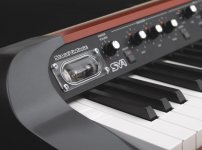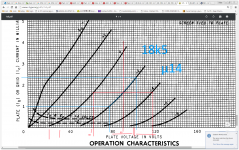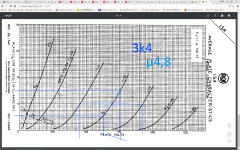Korg already has products including tubes in the audio stage for that "analog warmth" but if it doesn't look (and glow) like real tubes and can't be put behind a small window to attract/impress customers the commercial appeal will be small, not a good marketing idea IMO. (look at Korg's SV-1 below for a good exemple). Maybe the small size, low consumption and low voltages required for the VFD tubes are advantageous for small battery-powered FX-pedals including tubes. It's very unlikely these VFD tubes will be ever offered to the open market/hobbyist community by Korg, or maybe in very limited quantities as spare parts for their products.
Attachments
Well it should be, because DM160 is the very first VFD tube ever made.
Of course it has a spiral wire anode and isn't "multi-segment" like modern VFD displays.
Of course it has a spiral wire anode and isn't "multi-segment" like modern VFD displays.
Now I want to make a battery operated portable amp with these using my favourite balanced tube circuit!
I don't know if mere mortals (or small companies) will ever have access to these but there are a couple of key specs that does make them quite different from "old" tubes.
Maximum plate dissipation 1.7 MILLIWATTS, can't red plate this one.
Plate voltage is 5 to 80 (max) volts.
Anode current 10 to 34 microamps.
Mu is 12.
Gm is 40 uA.
Positive grid voltage is required for most applications, but grid current is less than 14 microamps, which is almost as much as the plate current.
No word about microphonics, but it is a DHT with a suspended filament. I still think it could be useful for a preamp mounted inside the guitar. A two stage tube preamp operating both sections at the maximum ratings would consume less than 30 milliwatts including both filaments! The curves look quite linear especially when operated near the maximum ratings.
Maximum plate dissipation 1.7 MILLIWATTS, can't red plate this one.
Plate voltage is 5 to 80 (max) volts.
Anode current 10 to 34 microamps.
Mu is 12.
Gm is 40 uA.
Positive grid voltage is required for most applications, but grid current is less than 14 microamps, which is almost as much as the plate current.
No word about microphonics, but it is a DHT with a suspended filament. I still think it could be useful for a preamp mounted inside the guitar. A two stage tube preamp operating both sections at the maximum ratings would consume less than 30 milliwatts including both filaments! The curves look quite linear especially when operated near the maximum ratings.
From what I can tell, as a tube it is extremely weak, which is why in that datasheet it needs both input and output buffers.
It is obviously a gimmick for sprinkling some 'tube sound' onto a solid-state circuit and then selling to gullible punters. Not a serious valve, but an excellent marketing tool.
How?
Just contact Hiroyuki Hiruta at the site.
Nutube – English | korgnutube.com – English
I gone test it as MC phono pre preamp.
Last edited:
I know.
But I like to expirement with these tubes.
If I cannot use them in a circuit, they are fine samples for my tube collection.
But I like to expirement with these tubes.
If I cannot use them in a circuit, they are fine samples for my tube collection.
Last edited:
Given who makes them the intended purpose appears to be as part of an effects signal chain in MI applications.
I'm trying to get one of these ordered to play with a well. Would make a sweet battery amp for those 12+ hour flights I take a few times a year. Might even be able to make it USB powered to just plug into the seat!
[This is arguably a commercial post, so if moderators find it so, sorry, and please delete it]
The Korg NuTube 6P1 is now available in small quantity online. Please see the thread in "vendors bazaar" for more info.
Pete
The Korg NuTube 6P1 is now available in small quantity online. Please see the thread in "vendors bazaar" for more info.
Pete
- Status
- Not open for further replies.
- Home
- Amplifiers
- Tubes / Valves
- New tube tech from Korg


